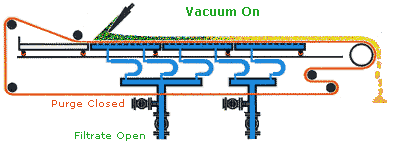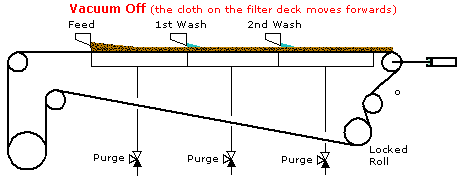
|
Click on the
thumbnail to maximize the image |
The Tray Filter, as opposed to the Horizontal Belt Filter, is relatively new to the chemical process industries and its main feature is that it lacks the traditional rubber belt. It belongs to the group of top feed filters and is primarily applied to the finer chemical compounds handling thin cakes although in recent years large machines suitable for thick cakes may be seen on the bulkier processes.
Sizes may vary from 0.25 to 3.0 meter wide units and lengths of 2 meters for pilot units and up to 25 meters for industrial machines, hence, the range of effective filtration areas is from 0.5 to 75 m2.
There are basically two design concepts both of which use indexing with the "vacuum on" during filtration and "vacuum off" for a very short time to enable a new "vacuum on" cycle:
The cloth moves continuously over reciprocating trays which move forwards with "vacuum on" in the forward stroke and retract with "vacuum off" in the backwards stroke.
The cloth moves intermittently over fixed trays and stops with "vacuum on" in the filtration phase and "vacuum off" to enable its movement forwards.
This filter consists of a series of trays which are allocated for cake formation, washing and drying. The trays are each connected through a flexible hose to a manifold that runs along the filter and collects the filtrate to vacuum receivers. To meet such requirements the manifold is separated by blind flanges which can be set at different positions to suit any specific application such as separating mother from wash filtrates or counter-current washing in several stages. The number of receivers is determined by the process requirements with one unit collecting the mother filtrate and others the wash filtrate and the cake drying.
|
To view the components move the mouse pointer over the menu
|

|
|
The reciprocating trays are designed so that, while under vacuum, they can move freely in the forward direction together with the cloth and at the same velocity . When they reach the end of stroke point the vacuum is cut-off, the trays are purged by an atmospheric release and pulled back by an air driven pneumatic cylinder. During the backstroke the filter cloth keeps moving forwards since there is no vacuum between the retracting trays and the backside of the cloth which holds them together.
The vacuum and purge modes are controlled by 3-way solenoid actuated valves with one valve located at the end of the manifold and the others on the inlets to the vacuum receivers. Just before the manifold valve opens to purge the trays the valves on the receivers get closed so that there is no interruption in the vacuum level downstream the filtrate outlets. The trays then enter backstroke and when they reach their end position the manifold valve closes and the receiver valves opens so that the trays are again under vacuum and ready for a new cycle. With efficiency in mind the backward stroke is fast so that the ratio of filtration time to downtime will be as high as possible.
|
A typical flow scheme with two co-current washing stages is shown on the right. The trays are fixed and the cloth moves forwards as explained below.
|
|
The Fixed Trays Type The trays of this filter are fixed to the frame and the cloth moves forwards in short increments during "vacuum off" and remains stationary at the "vacuum on" mode. The vacuum modes are controlled by solenoid actuated valves arranged in a similar method described in the section on the Reciprocating Trays Filter. Cake discharge is achieved by one of two systems:
|
|
| To view the components move the mouse pointer over the menu
|

|
|
Play the movie to watch how the cake forms and dries under the stationary
cloth
with vacuum "on" and discharges from the moving cloth when vacuum is "off"
.
Fixed roll with "on-off" motor actuator
In this system the discharge roll is mounted on the frame in a fixed position and a timer controlled pulley moves the cloth at "vacuum off" to allow cake discharge and "vacuum on" during filtration. A special tilting feed box pours the slurry onto the filter deck when the cloth moves at "vacuum off".
Tilting Slurry Feed Box Fixed Cake Discharge Roll Cloth Drive Pulley Cloth Take-up Roll Cloth Aligning Mechanism Wash Boxes Mother Filtrate Outlet Wash Filtrate Outlets
mouse pointer over the menu
![]()
![]()
![]()
Selection Criteria
Tray type filters are generally selected in the following cases:
They may be built from synthetic materials of construction which makes them suitable to withstand highly corrosive applications without the use of exotic and expensive alloys.
The sealing against loss of vacuum is simple as opposed to the rubber belt filters which use sacrificial moving belts to seal between the underside of the main belt and the top flanges that run along the vacuum box.
They are built in a modular construction which enables expansion when circumstances so require.
The separation of mother and wash filtrates is sharp and accurate since, as opposed to partitions in a vacuum box of a rubber belt filter, the filtrate is contained in a tray.
They lend themselves better than rubber belt filters when two vacuum zones are required such as high vacuum for the feed and wash zones and low vacuum with high air rates for the drying zone.
The power consumption is lower since the rubber belt filters require special arrangements to support the heavy belt and reduce friction.
Features are found more often on tray filters such as gas tight enclosures, compression rolls and blankets, thermal drying, vibrating trays to seal cracks in the cake and ultrasonic or chemical cloth cleaning.
They are however less in use for very thick and heavy cakes since, contrary to rubber belt filters, the friction during indexing due to the cake weight between the supporting grids that cover the trays and the backside of the cloth may cause extensive wear.
Operational Sequence
The Reciprocating Trays Type
The indexing sequence is done in two stages:
Trays are in forwards stroke
The trays are under vacuum and the filtration cycle takes place. The trays move together with the cloth and the cake until they reach the foremost position.
Trays are in return stroke
Vacuum is cut-off and the trays are retracted very quickly whilst the cloth with its cake are moving on. When they reach the backmost position forwards stroke commences and the cycle is repeated.
The indexing sequence for the type with the moving discharge roll (shown in the animation above) is done in two stages:
Cloth on the filter deck remains stationary
The trays are under vacuum and the filtration cycle takes place. The cloth is stationary with the discharge roll in the foremost position and moves slowly backwards so that the cake falls into the chute. Simultaneously, the slack take-up roll in its uppermost position and moves slowly down by gravity to keep the cloth tight. At the same time a solenoid valve opens the water to the wash manifold and the cloth is cleaned by high impact flat jet nozzles to dislodge any solid particles that are entrained in the cloth. When the discharge roll reaches its backmost position vacuum is turned off to enable the cloth to move one pitch forwards.
Cloth on the filter deck moves forwards
Vacuum is cut-off and the trays are open to atmospheric purge to allow the movement of the cloth. At this point the discharge roll moves very quickly forwards and pulls the cloth with its cake by one pitch. Simultaneously, a ratchet locks the cloth locking roll so that the cloth is kept tight by the upwards movement of the slack take-up roll.
Maintenance
As opposed to rubber belt filters, there are practically no sealing problems with tray type filters.
The main assemblies that require inspection for preventive maintenance are:
The condition of the flexible hoses, the tray support rollers and tracks on the reciprocating type filters.
The condition of the pneumatic cylinders, cloth aligning mechanism and the control panel on both reciprocating and fixed type filters.